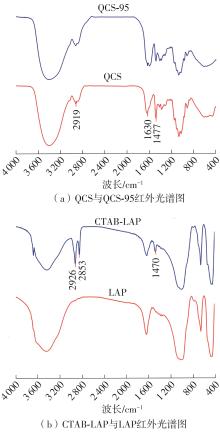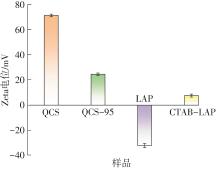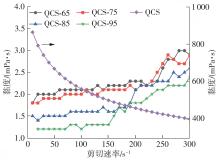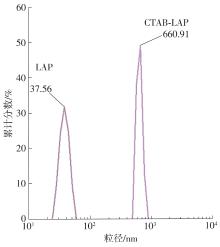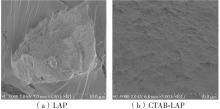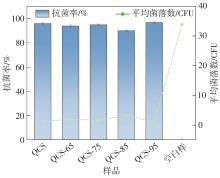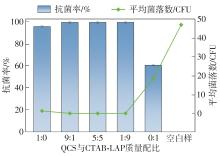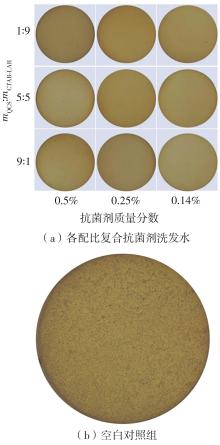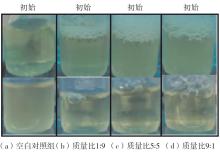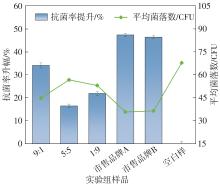Journal of South China University of Technology(Natural Science Edition) ›› 2025, Vol. 53 ›› Issue (8): 158-166.doi: 10.12141/j.issn.1000-565X.250015
• Materials Science & Technology • Previous Articles
Preparation and Application of Modified Chitosan/Laponite Composite Antimicrobial Material
LÜ Xiaojing, WEN Yuming, WANG Xiaoying, HU Jian
- School of Light Industry and Engineering,South China University of Technology,Guangzhou 510640,Guangdong,China
-
Received:2024-12-30Online:2025-08-25Published:2025-03-12 -
Contact:王小英(1978—),女,教授,博士生导师,主要从事生物质高值化利用研究。 E-mail:xyw@scut.edu.cn -
About author:吕晓静,女,博士生,工程师,主要从事日用化工材料及产品研究。E-mail: 201811007231@mail.scut.edu.cn -
Supported by:the Natural Science Foundation of Guangdong Province(2020B1515120038)
CLC Number:
Cite this article
LÜ Xiaojing, WEN Yuming, WANG Xiaoying, HU Jian. Preparation and Application of Modified Chitosan/Laponite Composite Antimicrobial Material[J]. Journal of South China University of Technology(Natural Science Edition), 2025, 53(8): 158-166.
share this article
| [1] | FAERGEMANN J .Malassezia yeasts and pityriasis versicolor[J].Current Opinion in Infectious Diseases,2009,22(2):128-133. |
| [2] | HAY R J, GRAHAM-BROWN R A .Dandruff and seborrhoeic dermatitis: causes and Management[J]. Clinical and Experimental Dermatology,1997,22(1):3-6. |
| [3] | RO B I, DAWSON T L .The role of sebaceous gland activity and scalp microfloral metabolism in the etiology of dandruff[J].Journal of Investigative Dermatology Symposium Proceedings,2005,10(3):194-197. |
| [4] | TURNER G A, HOPTROFF M, HARDING C R .Stratum corneum dysfunction in dandruff[J].International Journal of Cosmetic Science,2012,34(4):298-306. |
| [5] | ZHANG Y, ZHANG X, LIU M .Malassezia species in seborrheic dermatitis and dandruff:a systematic review and meta-analysis[J].Mycoses,2013,56(3):267-275. |
| [6] | GRICE E A, SEGRE J A .The skin microbiome[J]. Nature Reviews Microbiology,2011,9(4):244-253. |
| [7] | DEANGELIS Y M, GEMMER C M, KACZVINSKY J R,et al .Three etiologic factors in dandruff and seborrheic dermatitis:malassezia fungi,sebaceous lipids,and individual sensitivity[J].Journal of Investigative Dermatology Symposium Proceedings,2005,10(3):295-297. |
| [8] | PONZIO R R, SURBER C .Safety and efficacy of pyrithione zinc in the treatment of dandruff[J].American Journal of Clinical Dermatology,2019,20(3): 351-358. |
| [9] | DRAELOS Z D .The effect of antidandruff shampoos on hair quality[J].International Journal of Cosmetic Science,2010,34(6):455-459. |
| [10] | MORAIS M G, FILHO P .The role of natural ingredients in treating dandruff[J].Journal of Cosmetic Dermatology,2005,14(2):151-157. |
| [11] | Commission European .Commission Regulation (EU) 2021/1902 of amending Annexes II and V to Regulation (EC) No 1223/2009 as regards zinc pyrithione [Z].Luxembourg: Publications Office of the European Union,2021. |
| [12] | LIU W R, YANG Y Y, LIU Y S .Biocides in the river system of a highly urbanized region:a systematic investigation involving runoff input[J].Science of the Total Environment,2018,624(5):1023-1030. |
| [13] | MUXIKA A, ETXABIDE A, URANGA J,et al .Chitosan as a bioactive polymer:processing, properties and applications[J].International Journal of Biological Macromolecules,2017,105(Pt2):1358-1368. |
| [14] | MOUZAHIM M EL, EDDRARAI E M, ELADAOUI S,et al .Food packaging composite film based on chitosan,natural kaolinite clay,and Ficus carica leaves extract for fresh-cut apple slices preservation[J].International Journal of Biological Macromolecules,2023,233:123430/1-11. |
| [15] | TANPICHAI S, SRIMARUT Y, WORAPRAYOTE W,et al .Chitosan coating for the preparation of multilayer coated paper for food-contact packaging:wettability,mechanical properties,and overall migration[J].International Journal of Biological Macromolecules,2022,213(7):534-545. |
| [16] | AKBARI-ALAVIJEH S, SHADDEL R, JAFARI S M . Encapsulation of food bioactives and nutraceuticals by various chitosan-based nanocarriers[J].Food Hydrocolloids,2020,105:105774/1-11. |
| [17] | XING X, HAN Y, CHENG H .Biomedical applications of chitosan/silk fibroin composites:a review[J].International Journal of Biological Macromolecules,2023,240:124407/1-20. |
| [18] | AUGUSTINE R, REHMAN S R U, AHMED R,et al .Electrospun chitosan membranes containing bioactive and therapeutic agents for enhanced wound healing[J].International Journal of Biological Macromolecules,2020,156(8):153-170. |
| [19] | FENG P, LUO Y, KE C,et al .Chitosan-based functional materials for skin wound repair: mechanisms and applications[J].Frontiers in Bioengineering and Biotechnology,2021,9:650598/1-15. |
| [20] | ZHAO R, MA T, ZHAO S,et al .Uniform and stable immobilization of metal-organic frameworks into chitosan matrix for enhanced tetracycline removal from water[J].Chemical Engineering Journal,2020,382:122893/1-11. |
| [21] | QIU Y L, LI Y, ZHANG G L,et al .Quaternary-ammonium chitosan, a promising packaging material in the food industry[J].Carbohydrate Polymers,2024,323:121384/1-14. |
| [22] | KIAEE G, DIMITRAKAKIS N, SHARIFZADEH S,et al .Laponite-based nanomaterials for drug delivery[J].Advanced Healthcare Materials,2022,11(7):e2102054/1-39. |
| [23] | MI Y, TAN W, ZHANG J,et al .Modification of hydroxypropyltrimethyl ammonium chitosan with organic acid:synthesis, characterization,and antioxidant activity[J].Polymers,2020,12(11):2460/1-16. |
| [24] | MOHAMMED M, SYEDA J, WASAN K M,et al . An overview of chitosan nanoparticles and its application in non-parenteral drug delivery[J].Pharmaceutics,2017,9(4):53-60. |
| [25] | ISLAM M M, MONDAL M I H, AHMED F .Study on prawn shell waste into chitosan and its derivatives as value added products for cellulosic fibres[J].Research Journal of Textile and Apparel,2017,21(2):134-145. |
| [26] | MA B, TAN W, ZHANG J,et al .Preparation and characterization of chitosan derivatives bearing imidazole ring with antioxidant,antibacterial,and antifungal activities[J].Starch-Stärke,2023,75(3/4):2200204. |
| [27] | YAO Y, YE Z, ZHANG Y,et al .Quaternary ammonium compounds and their composites in antimicrobial applications[J].Advanced Materials Interfaces,2024,11:2300946/1-19. |
| [28] | FREITAS E D, MORAIS C F, JONAS K,et al .An overview of current knowledge on the properties,synthesis and applications of quaternary chitosan derivatives[J].Polymers,2020,12(12):2878-2890. |
| [29] | RABEA E I, BADAWY M E, STEVENS C V,et al . Chitosan as antimicrobial agent:applications and mode of action[J].Biomacromolecules,2003,4(6):1457-1465. |
| [30] | MCBAIN A J, LEDDER R G, SMITH T,et al .Effects of quaternary-ammonium-based formulations on bacterial community dynamics and antimicrobial susceptibility[J].Applied and Environmental Microbiology,2004,70(6):3449-3456. |
| [31] | TISCHER M, PRADEL G, OHLSEN K,et al .Quaternary ammonium salts and their antimicrobial potential:targets or nonspecific interactions[J]. ChemMedChem,2012,7(1):22-31. |
| [1] | CHEN Gang, AO Jie, HE Yingying, WANG Chunyu, ZHANG Cheng. Study of Dye Adsorption Properties of Cellulose-Based Nanocellulose Aerogels [J]. Journal of South China University of Technology(Natural Science Edition), 2025, 53(8): 149-157. |
| [2] | LIU Pingan, LIN Baoshun, DING Huiling, et al. Preparation and Properties of Bacterial Cellulose Based CNFs/ZnO Microwave Absorbing Materials [J]. Journal of South China University of Technology(Natural Science Edition), 2024, 52(8): 138-145. |
| [3] | QI Chang, DING Chen, LIU Haitao, et al. Experiment and Simulation of In-Plane Crushing Performance of Circular Double-Arrow Honeycomb [J]. Journal of South China University of Technology(Natural Science Edition), 2023, 51(1): 61-68. |
| [4] | CHEN Mingdong HAN Guangze. Influence of Structural Parameters of Carbon Nanotubes on Its Dielectric Properties [J]. Journal of South China University of Technology (Natural Science Edition), 2021, 49(4): 74-79,89. |
| [5] | . Chromatic and near-infrared reflective properties of Zn2+ doped CaCuTi4O12 [J]. Journal of South China University of Technology(Natural Science Edition), 2019, 47(12): 86-91. |
| [6] | Chen Yong- jun Luo Yuan- fang Li Bin Lü Wei- xi Jia Zhi- xin Jia De- min He Yan- ling Zhang Xiu- qin. Amino-Functionalized Montmorillonite Modified via Mortar Grinding [J]. Journal of South China University of Technology (Natural Science Edition), 2013, 41(6): 121-126. |
| [7] | Liang Ji- zhao Jiang Xing- hua. Theoretical Sound-insulation Model of the Polymer/Inorganic Particle Composites [J]. Journal of South China University of Technology(Natural Science Edition), 2004, 32(10): 6-9. |
| Viewed | ||||||
|
Full text |
|
|||||
|
Abstract |
|
|||||
